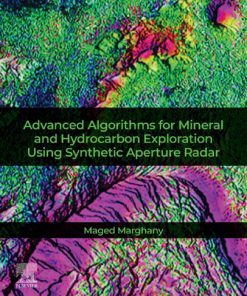Hydrocarbon Fluid Inclusions in Petroliferous Basins 1st Edition by Vivekanandan Nandakumar, JL Jayanthi ISBN 9780128174166 0128174161
$50.00 Original price was: $50.00.$25.00Current price is: $25.00.
Hydrocarbon Fluid Inclusions in Petroliferous Basins 1st Edition by Vivekanandan Nandakumar, JL Jayanthi – Ebook PDF Instant Download/Delivery: 9780128174166 ,0128174161
Full download Hydrocarbon Fluid Inclusions in Petroliferous Basins 1st Edition after payment

Product details:
ISBN 10: 0128174161
ISBN 13: 9780128174166
Author: Vivekanandan Nandakumar, JL Jayanthi
Hydrocarbon Fluid Inclusions in Petroliferous Basins trains readers to detect Hydrocarbon Fluid Inclusions (HCFIs) in sedimentary rocks, particularly the wafer preparation techniques to visualize HCFIs, its distinction from aqueous inclusions, petrographic approaches to HCFIs, microthermometric observations on HCFIs, fluorescence emission spectra and Raman spectra of HCFIs, and their interpretations for the petroleum industry. The book features case studies from the Mumbai and Kerala Konkan Basins of the Western Offshore of India – two representative basins where new, non-destructive, fluid inclusion techniques were tested. This book is essential reading for students of petroleum geology and those working in exploration in the oil and gas industry.
Helps readers to identify Hydrocarbon Fluid Inclusions (HCFIs) in sedimentary basins
Covers how to determine the oil window, API gravity and chemical constituents in HCFIs
Includes case studies on key offshore basins
Hydrocarbon Fluid Inclusions in Petroliferous Basins 1st Edition Table of contents:
Chapter 1. Introduction to fluid inclusions
Abstract
1.1 Entrapped fluids: Fluid inclusions
1.2 Significance of geofluids
1.3 Fluids of the sedimentary realm
1.4 Fluid inclusions in sedimentary and diagenetic systems
1.5 Occurrence and classification of fluid inclusions
1.6 The nature of petroleum fluids
1.7 Hydrocarbon-bearing fluid inclusions
1.8 Significance of fluid inclusion study
1.9 Importance of hydrocarbon-bearing fluid inclusions in petroleum exploration
References
Further reading
Chapter 2. Nondestructive analytical techniques for fluid inclusions
Abstract
2.1 Fluid inclusion analysis: Basics
2.2 Destructive and nondestructive analytical methods for fluid inclusions
2.3 Microthermometry
2.4 PVTX modeling
2.5 Fluorescence methods
2.6 Raman and Fourier-transform infrared (FT-IR) spectroscopy
2.7 Microthermometric analysis of fluid inclusions
2.8 Optical spectroscopic methods for HCFI analysis
2.9 Importance of fluid inclusion analysis
References
Chapter 3. Petroleum system and the significance of HCFI study
Abstract
3.1 Petroleum formation
3.2 Petroleum system
3.3 Petroleum maturation
3.4 Petroleum migration/migration of HCFIs
3.5 Physical properties of petroleum
3.6 Chemical properties of petroleum
3.7 Biomarkers in crude oil
3.8 Trapping of petroleum inclusions
3.9 Significance of HCFI study
References
Chapter 4. HCFIs—Examples from Mumbai and Kerala offshore basins in India
Abstract
4.1 Introduction
4.2 Geologic evolution of western Indian continental margin and its impact on hydrocarbon occurrences
4.3 Characteristics of petroleum inclusions
4.4 Mumbai basin
4.5 Kerala-Konkan basin
4.6 Comparison of fluid inclusions from Mumbai and Kerala offshore basins
References
Further reading
Chapter 5. Petrographic and microthermometric studies on HCFIs
Abstract
5.1 Introduction
5.2 Petrography: Identification of petroleum inclusions
5.3 Petrography: Relationship to the host mineral
5.4 Microthermometric analysis of petroleum inclusions
5.5 Significance of oil window in petroleum fluid inclusions: A microthermometric approach
5.6 Oil window: An Indicator of hydrocarbon potential in a basin
5.7 Summary
References
Chapter 6. Fluorescence spectroscopy in hydrocarbon fluid inclusions
Abstract
6.1 Fluorescence spectroscopy
6.2 Petroleum oil fluorescence
6.3 Steady-state and time-resolved fluorescence techniques
6.4 Fluorescence spectroscopy for hydrocarbon fluid inclusions
6.5 Fluorescence emission of oils and its relation to API gravity
6.6 Previous studies on fluorescence emission and API gravity of crude oils/HCFIs
6.7 Observations and highlights of the HCFI fluorescence emission study
6.8 Determination of the API gravity of oils in HCFIs from the Kerala-Konkan basin using the fluorescence emission technique
6.9 Comparison of API gravity of oils in HCFIs from dry wells in a proven and nonproven basin
6.10 Conclusions
References
Chapter 7. Raman spectroscopic studies of hydrocarbon fluid inclusions
Abstract
7.1 Introduction
7.2 Raman spectrometer
7.3 Challenges with Raman analysis
7.4 Choice of laser excitation
7.5 Importance of Raman studies in fluid inclusions
7.6 Raman analysis of HCFIs
7.7 Earlier studies on the Raman spectra of HCFIs
7.8 Raman spectra of HCFIs from Mumbai offshore, India
7.9 Raman spectra of non-HCFIs
7.10 Raman peaks of major constituents in HCFIs
7.11 Conclusions
References
Chapter 8. Conclusions and future perspectives in HCFI analysis
Abstract
8.1 Futuristic applications of HCFI analysis
8.2 Integration of fluid inclusion data with petroleum system modeling
8.3 Insight—A dream to reality
People also search for Hydrocarbon Fluid Inclusions in Petroliferous Basins 1st Edition:
hydrocarbon in water
hydraulic fluid carbon range
a hydrocarbon is hydrophobic
a hydrocarbon is hydrophobic quizlet
a hydrocarbon contains
Tags: Vivekanandan Nandakumar, JL Jayanthi, Hydrocarbon Fluid Inclusions, Petroliferous Basins
You may also like…
Physics - Mechanics: Fluid Mechanics
Science (General)
Uncategorized
Uncategorized
Mathematics - Others
Multi Valued Variational Inequalities and Inclusions Siegfried Carl Vy Khoi Le
Engineering











